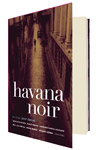In Lea Aschkenas’s “La Coca-Cola del Olvido,” one of eighteen stories collected in Havana Noir, drizzle turns to a downpour and “the few unfortunate souls still in the street ran as if on fire, intent on getting home before the dilapidated balconies above them began falling.” What makes the Havana of the seventeenth title in Akashic Books’ popular urban noir series so surly? Editor Achy Obejas writes in the introduction of a city where “the concept of sin has been banished by the urgency of need… [turning] the human heart feral.”
In 1991, the last shipment of Soviet oil entered Havana harbor, ending thirty years of Soviet economic aid to Cuba, and Fidel Castro announced the “Special Period in Peacetime” to gird the island’s 11 million inhabitants for the hardships that would follow. Cuba in the early 1990s became an island of contradictions. It was prohibited for a Cuban to carry dollars, but American money was the only currency accepted at most Havana businesses. At government stores, salesmen in name only sat all day behind empty old mechanical cash registers in front of stockless shelves. In dark, desultory cafeterias, waiters took monotonous orders for sugar water and stale congris of black beans and rice, the only items on the menu.
As collected in Havana Noir, the fictive repercussions of the Special Period range from absurd to terrifying. In “Nowhere Man,” Miguel Mejides constructs a (literally) underground syndicate of dwarves supplying the city above with black-market sausages. In “What for, This Burden” Michel Encinosa Fú introduces characters of cruelty so shocking you may need to set the book down. Leonardo Padura abandons the colorful cool of his Mario Conde mysteries for the spiraling decadence of “Staring at the Sun,” whose narrator gazes from a luscious mist of liquor and parkisonil upon greasy walls as the grotesques accumulate. “The black guy’s head explodes and rolls back. Even I get splattered with his blood. It’s practically black, like the dog’s, although it’s got little white dots.”
Obejas hardly gives herself credit, but she shines as a translator. (Besides contributing her own story, twelve of the translations are attributed to the editor.) Padura’s garrulous perversion is as distinct as the soliloquy of a deaf babalao in Arnaldo Correa’s “Olúo”: “In a quiet area, we fished for langostinos and cooked them in an old can of Spanish sausages that my father had brought in his bag…. Life can be so marvelous!” Obejas’s translation of “The Red Bridge” by the author Yoss captures the idiom of a pair of outcast socios from El Patio: “If he bends to get the blade in front of Yako, those Nike 48s are gonna leave footprints all over his face.”
Perhaps this Havana is so surly because she is for sale, pimped by the government and by every Habanero out to make an American buck. In Mylene Fernández Pintado’s “The Scene,” a bureaucrat making room for a tourist remodel evicts a woman caring for her ailing mother. “Everything was architecturally and financially aligned. Emptying the building was just the first task.” At its best, noir is in the darkness of the human heart. And in urban noir, humanity is the darkness at the heart of the city. In Havana Noir, better than half the stories are truly gripping, and all of them resuscitate a dark Havana that seethes beneath the idealized island of our imagination.





